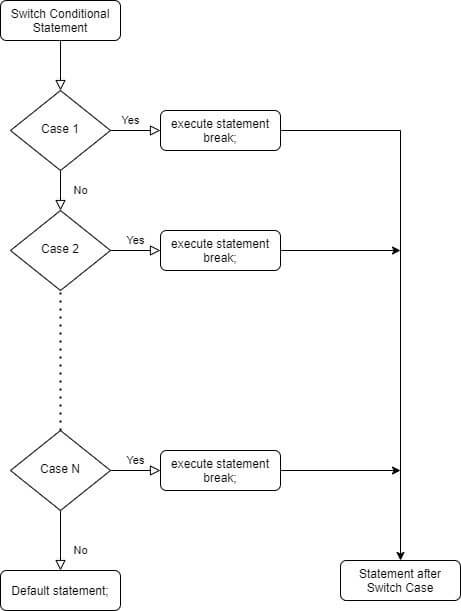Switch Statement in C and C++ ? Where to use Switch Case?
A switch statement is a control flow statement, which allows us to decide which statement will be executed, based on a condition.
A switch statement has several types of statements, such as case statements and break statements. A case statement is used to specify a different sequence of code based on a condition.
Sometimes there is a situation where you want multiple if-else conditions but writing and maintaining all the sequences and choices can become difficult and even complicated. In simple words, consider this example:
Let say, you have an application that takes an integer input to find a month in a year. Then, it would be better to go with switch statements without going to 12 times if-else statements for every month. The syntax for switch case:
Switch (choice)
{
Case 1: // if choice is equal to 1
Break;
Case 2: // if choice is equal to 2
Break;
……..
Default : // this executes if none of the case matches.
}
Flowchart for Switch in C and C++

Some facts about switch conditions
- The expression inside the switch function should be a constant value or valid expression, else it might through error. For example,
Switch (2+8/2) // it is valid
Switch (10-b+1) // it is invalid
- Don’t use duplicate case, it can lead to error.
- Always use break statement ( though it’s optional ) , else it will match other case and also execute till the last statement in switch condition.
- The Default statement is optional, but it is advise to use it for good programming practice.
- You can also perform nesting switch statement, i.e, switch case inside of another switch statement. But try to avoid it, as it might increase difficulty in reading the code.
Example of Switch Condition
#include<iostream>
using namespace std;
int main()
{
int n;
cout << "Enter the month in numbers" << endl;
cin >> n;
switch (n)
{
case 1:
cout<<"January"<<endl;
break;
case 2:
cout<<"February"<<endl;
break;
case 3:
cout<<"March"<<endl;
break;
case 4:
cout<<"April"<<endl;
break;
case 5:
cout<<"May"<<endl;
break;
case 6:
cout<<"June"<<endl;
break;
case 7:
cout<<"July"<<endl;
break;
case 8:
cout<<"August"<<endl;
break;
case 9:
cout<<"September"<<endl;
break;
case 10:
cout<<"October"<<endl;
break;
case 11:
cout<<"November"<<endl;
break;
case 12:
cout<<"December"<<endl;
break;
default :
cout<<"Invalid month have been entered "<<endl;
}
return 0;
}Output
Enter the month in the number
3
March

